ESC Hybrid system components - removal and refitting
Note: Procedures for removal and refitting of the ignition system components and electronic module are given elsewhere in the relevant Sections of this Chapter.
1 Disconnect the battery negative lead.
Crankshaft speed/position sensor 2 The sensor is mounted in a bracket on the timing cover.
3 Disconnect the sensor wiring plug by pulling on the plug, not the wiring (see illustration).
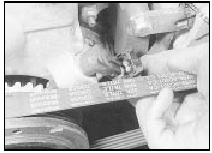
20.3 Disconnecting crankshaft speed/position sensor wiring plug - ESC Hybrid
system
4 Slacken the sensor clamping screw and slide the sensor from its bracket.
5 Refitting is a reversal of removal, but the clearance between the sensor and the toothed wheel on the crankshaft must be set at 1.0 mm (0.04 in). This can be achieved by inserting a suitable length of wire or rod with a diameter of 1.0 mm (0.04 in) between the sensor and the toothed wheel (see illustration).
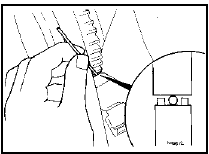
20.5 Setting the gap between the crankshaft speed/position sensor and the
crankshaft toothed wheel - ESC Hybrid system
Do not overtighten the clamping screw, as damage to the sensor may result.
Engine coolant temperature
sensor
6 The sensor is located in the side of the inlet
manifold (see illustration).
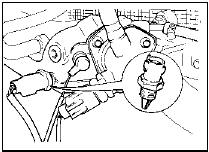
20.6 Engine coolant temperature sensor location - ESC Hybrid system
7 Partially drain the cooling system.
8 Disconnect the sensor wiring plug by pulling on the plug, not the wiring.
9 Unscrew the sensor from the inlet manifold and remove it.
10 Refitting is a reversal of removal. Fill the cooling system.
Air charge temperature sensor 11 The sensor is located in the base of the air cleaner.
12 Remove the air cleaner.
13 Disconnect the sensor wiring plug by pulling on the plug, not the wiring (see illustration).
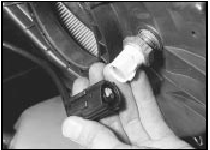
20.13 Disconnecting air charge temperature sensor wiring plug - ESC Hybrid
system
14 Unscrew the sensor from the air cleaner using a suitable spanner.
15 Refitting is a reversal of removal. Refit the air cleaner. Ensure that the vacuum hose is securely connected.
Electric choke heater
16 The electric choke heater is an integral
part of the automatic choke housing on the
carburettor. Removal and refitting of the
choke housing is covered in Chapter 4.
17 The operation of the electric choke heater relay can be checked by starting the engine from cold, and placing a finger on the relay (see illustration). It should be possible to feel the relay switching on and off. If this is not the case, renew the relay.
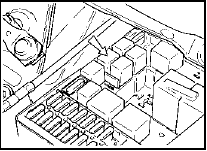
20.17 Electric choke heater relay location (arrowed) in main fusebox - ESC
Hybrid system
Throttle damper control solenoid 18 The solenoid is on the right-hand side of the engine compartment (see illustration).
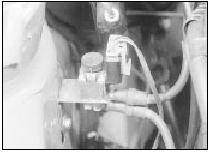
20.18 Throttle damper control solenoid - ESC Hybrid system
19 Disconnect the solenoid wiring plug by pulling on the plug, not the wiring.
20 Disconnect the two vacuum pipes from the solenoid, noting their locations for use when refitting.
21 Remove the securing screw and withdraw the solenoid from the body panel.
22 Refitting is a reversal of removal, but note that the locating lug on the solenoid bracket should engage with the body panel, and make sure that the vacuum pipes are correctly connected.
Throttle damper
23 Remove the air cleaner.
24 Disconnect the vacuum pipe from the throttle damper.
25 Remove the two securing screws and detach the throttle damper and bracket assembly from the carburettor (see illustration).
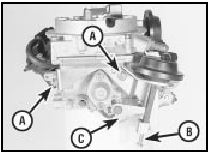
20.25 Throttle damper assembly - ESC Hybrid system
A Securing screws
B Adjusting screw
C Throttle lever
26 Commence refitting by securing the throttle damper and bracket assembly to the carburettor with the two screws. Ensure that the throttle lever is correctly positioned in the slot in the throttle damper actuating arm.
27 Reconnect the vacuum pipe to the throttle damper.
28 Reconnect the air cleaner vacuum hose to the inlet manifold, and reconnect the air change temperature sensor wiring plug, then place the air cleaner to one side to allow access to the throttle damper.
29 Reconnect the battery negative lead.
30 Connect a tachometer to the engine in accordance with the manufacturer’s instructions.
31 Start the engine, then check and if necessary adjust the idle speed and mixture.
32 Earth the “service adjustment” lead, located in the battery negative wiring loom (see illustration), for a minimum of 10 seconds. The throttle damper actuating arm should move to the fully retracted position, raising the engine speed.
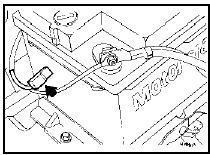
20.32 Service adjustment lead location (arrowed) - ESC Hybrid system
33 The engine speed should stabilise at 1700 ± 100 rpm. If adjustment is necessary, turn the adjusting screw on the end of the throttle damper actuating arm to give the correct speed. Turn the screw clockwise to increase the engine speed, or anti-clockwise to reduce the engine speed.
34 On completion of adjustment, stop the engine and disconnect the tachometer.
35 Where necessary, ensure that any tamperproof seals are refitted, then refit the air cleaner, ensuring that the vacuum hose is securely connected. Isolate the “service adjustment” lead.
36 Start the engine and check that normal idle speed is resumed, then stop the engine.
See also:
Rear suspension and final drive unit assembly (Saloon, Hatchback and Estate
models) - removal and refitting
Note: From May 1986, revised final drive unit
rear mounting bolts have been used in
production. Whenever the earlier type of bolts
are removed, they should be discarded and
the later type fitted. ...
Load apportioning valve P100 models) - removal and refitting
Caution: Refer to the
precautions in Section 1.
Removal
1 Chock the front wheels, jack up the rear of
the vehicle and support on axle stands (see
“Jacking and Vehicle Support”).
2 The load appor ...
Air conditioning system - component renewal
1 Only those items which can be renewed
without discharging the system are described
here (see illustration). Other items must be
dealt with by a Ford dealer or air conditioning
specialist.
21. ...
